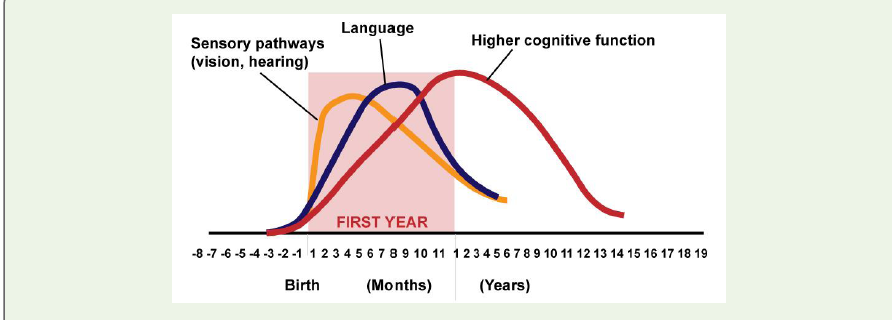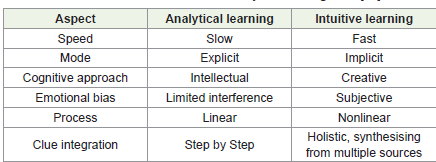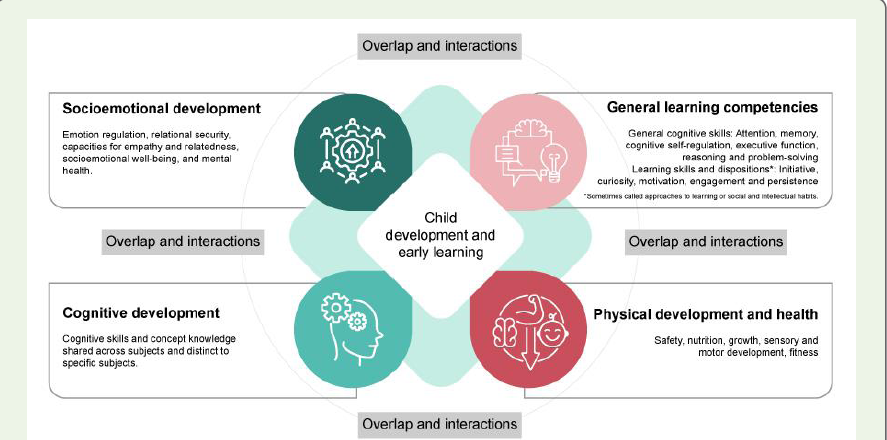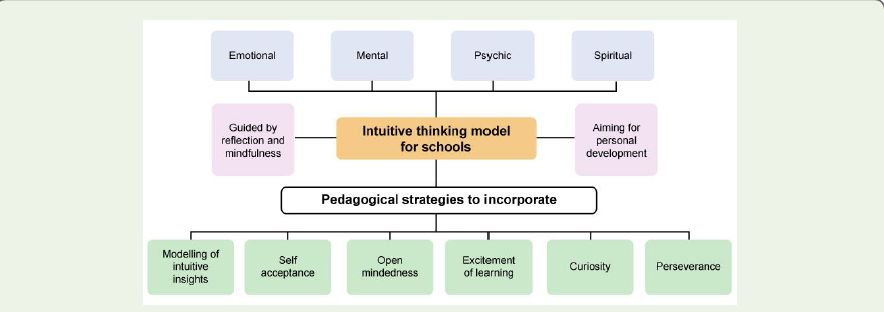Review Article
Childhood Learning and Education: A Focus on Intuitive Learning
Gowda VK1*, Ravi Kumar CP2, Goyal R3, and Sidhwani S4
1Department of Paediatric Neurology, Indira Gandhi Institute of Child Health, Bengaluru, India.
2Consultant Paediatric Neurologist, Aster NEUKIDS, Aster CMI Hospital, Bengaluru, India
3Clinical Psychologist, Department of Psychology, Kidicious, Delhi, India.
4Psychotherapist and Psychologist, Department of Psychology, Reality and You Foundation, Mumbai, India.
2Consultant Paediatric Neurologist, Aster NEUKIDS, Aster CMI Hospital, Bengaluru, India
3Clinical Psychologist, Department of Psychology, Kidicious, Delhi, India.
4Psychotherapist and Psychologist, Department of Psychology, Reality and You Foundation, Mumbai, India.
*Corresponding author:Vykuntaraju K Gowda, Department of Paediatric Neurology, Indira Gandhi Institute of Child Health, Bengaluru, India. E-mail Id: drknvraju08@gmail.com
Article Information:Submission: 06/03/2024; Accepted: 02/04/2024; Published: 05/04/2024
Copyright:© 2024 Gowda VK, et al. This is an open access article distributed under the Creative Commons Attribution License, which permits unrestricted use, distribution, and reproduction in any medium, provided the original work is properly cited.
Abstract
Findings of early cognitive expansion have led investigators to recognise the developing mind as astoundingly competent, active, and intuitive from an early age. For emotional, cognitive, social, and physical development, the first eight years from birth are crucial. As billions of mixed neuronal circuits
are built by the interplay of heredity, environment, and experience, a child’s developing brain is highly malleable and adaptable throughout these formative years. Intuitive learning plays a significant role in teaching, learning, and leadership, and theorists have recognised its role in scientific and artistic discovery. Education and intuition are the creative pathways to creativity. Incorporating intuitive learning into the educational system is crucial for adopting a holistic approach to thinking. Intuitive competence aids in creative thought processes in dynamic, networked or distracting workplaces. The present review is an
attempt to understand the potential of intuitive learning in the context of childhood education and its future implications.
Keywords:Cognitive; Childhood; Intuitive; Education; Learning
Abbreviations
ECCE; Early Childhood Care and Education; ECD; Early Childhood Development.
Introduction
The initial years of childhood, encompassing the period until
the age of 8 years, play a key role in the development of cognition,
social skills, emotional well-being, and physical growth. During these
years, a child’s newly developing brain is substantially plastic and
responsive to transformation as billions of mixed neural circuits are
formed via the interaction of environment, genetics, and experience.
It has been well noted that optimum brain development demands a
stimulating environment, adequate nutrients, and social interaction
with attentive caregivers [1]. The foundational framework of the brain
develops through a continuing process that commences before birth
and extends into adulthood. The sequential pattern in which the
brain matures provides windows of sensitivity that are particularly
susceptible to environmental influences. Basic vision and hearing are
the first sensory pathways to develop, followed by early language skills
and higher cognitive functions. It is a pattern of connections that
proliferates and prunes in a prescribed order, building upon earlier,
simpler circuits to create later, more complex circuits [2] [Figure 1].
Thus, the brain’s sensitivity to learning occurs in three broad waves,i.e.
sensory, language, and higher cognition, which also parallels the
sequence of emerging behavioural skills and milestones [3].
Early childhood development (ECD) is a maturation process
Figure 1:Neural connections for different functions develop sequentially [2].
that occurs in the first few years of life and involves the growth of
motor, cognitive, linguistic, and socioemotional skills. There is a delay
when a child does not meet developmental milestones in any area of
functioning at the anticipated age [4]. Additionally, early childhood
experiences impact brain architecture to such a great extent that they
can establish either robust or fragile foundations for lifelong learning,
behaviour, and well-being [1-8]. [Figure 2] shows the interconnected areas of child development and initial learning and how each domain
facilitates and jointly assists learning and development in the others
[7].
Findings of primary cognitive development have led investigators
to recognise the progressing mind as remarkably capable, active, and
intuitive from the early years. General cognitive processes are linked
to learning abilities including engagement and perseverance [7]. It is
noteworthy to mention that learning occurs in two forms, i.e. explicit
learning, which is an intentional,conscious, and declarative process
of knowledge acquisition, and implicit learning, which is a form of
incidental, unconscious, and procedural knowledge acquisition [9].
The process of learning begins at the prenatal stage. As soon as they
come into the world, children are ready to learn, and they actively
absorb information.One striking discovery about young infants is
that they construct their intuitive plots of certain cerebral functions
from the initial years of life. Furthermore, it is well studied that from
birth onwards, children’s minds are operational and curious, and
early thinking is intuitive and complex. Numerous foundations of
refined forms of learning, particularly those critical to intellectual
accomplishments, are laid during these initial years of life. A child’s
developing theory of mind transmutes how they interact with people
and what they learn from them. Infants and young children begin to
recognise what goes on in people’s mindsets, and how someone else’s
feelings and judgments are comparable with and inherent to them [7].
Beginning of Intuitions in Early Life:
Children are not inactive observers who register the superficial
manifestation of things at an early age. Instead, they build explanatory
systems – implicit theories or schemas – that help organise their
knowledge. Implicit theories encompass causal principles and
relationships; these concepts assist children in clarifying, reasoning,
and predicting significant events and, in some instances, interfering
to change them [7]. Initially, infants possess a relatively simple
understanding of the mind. They are conscious of some basic features:
what people are looking at is an emblem of what they are attending
to; individuals act intentionally and are goal-oriented; people have
positive and negative emotions in reaction to their surroundings; and
they possess varied perceptions, have different acuities, objectives, and
feelings. Children contribute to this mental atlas as their awareness
broadens. From an early age, developing a theory of mind has a
profound impact on everyday communal exchanges. This influences
how children learn, interact with others, evaluate morality, and form
their self-identity.Preschool children also are intuitive and experiential and learn
by engaging instead of imagining things out “in the head”. Before
entering formal, goal-oriented schooling, preschoolers gain a vast
breadth of arithmetical informal knowledge and intuitive thinking.
Young children are exposed to events in their daily lives that help them
develop abilities, concepts, methods, representations, viewpoints,
structures, and operations related to a wide scale of arithmetical
concepts [10]. Studies focussed on assessing the intuitive and informal
knowledge in preschoolers postulated that children aged 4–6 years
convey a stable informal perception of guessing an outcome for a
desired task. It was further highlighted in these studies that children
at these ages appear to have prior instincts about probabilistic ideas.
These outcomes sustain the assumption that preschoolers have the
cognitive capability and intuitions to retrieve simple concepts of
probability, notably the chance of events [10-12]. Intuitions emerge
early in life, and they are linked to networks in the brain and comprise
different sets of genes[13,14].
Intuitions can originate in formal and informal situations,
although intuitive thinking is primarily connected with informal
knowledge in the early years. Before formal schooling, young infants
are required to assess the chances and unpredictability of a task
and make probability judgments to a certain level [10]. Intuition is
vital in teaching, learning, and leadership, and theorists have long
recognised its relevance in scientific and artistic discoveries. From
the above discussions, the significance of intuitive learning cannot
be underestimated during the early years of life. Thus, integrating
such learning abilities may be a vital component of Early Childhood
Care and Education (ECCE). An effective early childhood learning
programme that can ensure appropriate chances for holistic
learning is warranted [15]. The present review article is an attempt
to understand the potential of intuitive learning in the context of
childhood education and its future implications.
Intuitive Learning vs. Analytical Learning:
The term “intuition” is a conceptual workhorse that describes
a wide variety of occurrences. The Latin root of the word, tueri,
translates to “to look at or towards, to contemplate” or “to look upon”
and intuitus to “the act of achieving knowledge from direct perception
or contemplation”[16]. Moreover, it has been well documented that
intuition is the examination of internalised, condensed knowledge.
In addition to this, some of the broad key aspects associated with
intuitive learning are as follows: [13,16-19]Intuition and analysis are sometimes represented in opposition,
which can be a helpful approach to understanding how each of
these modes works. Latest ideas and breakthroughs emerge from the
interaction of intuition and logic regularly. Table 1 elaborates on the
difference between intuitive and analytical learning skills [16]. Despite
differences, intuitive and analytical learning styles complement each
other. It is the equilibrium between sensing and intuition that makes
it feasible to apply the who legamut of rational and emotional insight
and judgment for overall activities [16-19]. Nevertheless, intuition
Table 1: Difference between intuitive and analytical learning skills [16]
is called a “sacred gift” and the rational mind a “faithful servant” as
the very interplay between intuition and logic helps generate new
thoughts and creativity repeatedly [17].
It is fascinating to know that intuition has been discovered to be
necessary for cognitive methods, such as heuristic-based decision making,
innovation, and learning. Intuition seems to be reliant on
double hemispheric inferior parietal and caudate structures of the
brain. Functionally and neurally, intuition is strongly correlated to the
development of expertise, heuristics, and generation of effective ideas
during the stages of preparation and incubation [20,21].
Evidence to Support That Children Are Intuitive Scientists:
The learner as an intuitive researcher, creates and tests
assumptions about the world providing a fruitful model that enables
one to understand the underlying cognitive growth[22,23]. Children’s
intuitive theories are shown to develop significantly in the preschool
years in a variety of areas, such as biological transmission and
contagion psychosomatic events [19]. A study involving 4- to 6-yearold
preschoolers aimed to investigate whether children tend to choose
informative actions and draw precise conclusions from the results
of their intrusions in a causal learning task. The findings indicated
that young children indeed exhibit a preference for informative
interventions and successfully make precise inferences based on the
end results of their actions in a novel causative system.The findings
suggest that young learners can grasp the principles of informative
experimentation well before they can articulate these strategies in
explicit scientific tasks [23]. Children’s intuitive theories, like scientific
theories, are developed, tested, and rationally amended in such a way
that integrates their prior knowledge with new evidence [19].Another study reported that young ones at an intermediary
phase of the intuitive theory are mostly determined to discover
domain-relevant information. When they know just enough about
something to be fascinated but not so much that they lose interest,
they are more likely to learn more about it. This optimum amount of
existing knowledge may establish a maximal amount of uncertainty
and curiosity in children and encourage them to learn more [19]. It is
further established that infants may already be born with explorative
abilities and knowledge about objects around them and may have
an innate ability to envisage the behaviour of objects and substances
with which they engage and relate. The intuitive knowledge of physics
is believed to be present, which is persuaded in children by playing
and allowing them to constantly interact with objects [24,25].
Several studies have highlighted the fact that children have robust
intuitive math capabilities before they begin formal math education
[26]. It has been stated that pre-schoolers obtain a widespread array
of mathematical abilities before entering formal, goal-oriented
education. One such study examined preschoolers’ intuitive
understanding of the chances of events in a probabilistic task with
spinners. Participants, at the age of 4–6 years, were tested on their
predictions of the most likely outcome before and after an instructive
session of reasoning. Findings revealed that children at the age of
4–6 years convey a stable informal understanding of foretelling an
outcome as more likely. Children at these ages seem to acquire prior
intuitions involving probabilistic models. These results suggest
that preschoolers possess the cognitive abilities and intuitive
Figure 2:Organisational approach for the domains of child development and early learning [7].
understanding to grasp fundamental concepts of probabilities,
especially in relation to the likelihood of events [12].
In an interesting finding, it was noted that 2-year–olds intuitively
used mathematical concepts, such as probability, to understand things
around them [27]. In another study that examined the consequence
of evidence conflicting with preschoolers’ naive theory on the forms
of their unrestricted exploratory play, it was found that all children
who noticed conflicting evidence performed an unconfounded (free
from state of confusion) informative experiment at the beginning
of their play. Outcomes showed that children in the conflicting
condition enacted more size experiments than children in the
confirming condition. Children who were confronted with theoryviolating
evidence planned experiments to validate their theory.
Pre-schoolers were more flexible when it came to performing diverse
types of experiments. But they were less flexible when it came to their
investigations. They could design experiments that were clear and
devoid of confounding variables. However, they lacked the ability
to switch the focus of their research and frequently drew wrong
conclusions from the tests they conducted [28].
The ability to grasp causal connections through the observation of
imperfect evidence is regarded as a valuable social learning mechanism
for toddlers. Mostly, children learn about causal relations amid objects
by viewing the acts of others. Studies have suggested that children as
young as 2 years of age can make use of observational causal learning
from probabilistic contingencies [29]. They use their sensitivity to
statistical models to discover the causal structure of the physical world
at an incredible speed despite the uncertain evidence they receive. The
ability of toddlers to act on the physical world – to create and conduct
their intercessions based on observable probabilistic evidence –
provides them with a stout structure for learning many sorts of causal
linkages, involving culturally unique aspects [29].
Encouraging Intuitive Learning in Children: Opportunities and Challenges:
Einstein rightly stated,‘Education is that which remains
when one has forgotten everything learned in school’ [17]. The
propensity to underestimate young children’s cognitive abilities
persists throughout the preschool and kindergarten years. In
one study, preschool instructors, and other professionals in
consulting, educational research, teacher tutoring, and educational
advancements underestimated children’s accomplishments by six to
eight times. This underestimation signifies a missed chance that can
hinder the development of children.In this regard, it is important to
inculcate intuitive learning in the education system to have a balanced
thinking approach [7].Education should concentrate on creating a generic climate that
encourages intuition. Whether it is to cultivate the internal receptivity
that allows people to identify intuitive experiences in the first place,
or to cultivate an environment that recognises intuition as valid and
valuable and encourages people to share intuitive content, educating
for intuition requires an attitudinal shift, including receptivity to
the unconscious and imagination. To prepare children for lifelong
learning, it is important that teaching includes the modelling of
intuitive insights, self-acceptance, open-mindedness, anticipation
for learning, curiosity, and persistence. A simple model explaining
the types of intuitive thinking and the pedagogical approaches that
could be integrated in to the 21st-century classroom is presented in
[Figure 3] [17].
Figure 3:Models to promote intuitive thinking [17].
Education and intuition are the creative pathways to in (novation.
Intuition may help leaders think about possibilities that have not
yet materialised, and with the ability to see the big picture, move
organisations forward through innovation [18]. Intuition may be
especially useful for making judgements, assessments, and conclusions
when time is limited or when a decision must be made with just partial
information. In other words, intuition is important when cognitive
processes are less functional [16,30]. Educating intuition entails
fostering a mindset that believes in the intuitive function’s potential as
a valued source of knowledge. Most intuition education programmes
focus on normalising the potential of intuitive function and raising
students’ awareness to recognise intuitive experiences when they
occur. Students of intuition acquire techniques for more easily
accessing subconscious content, and training for intuition should also
include experience in determining when it is appropriate to guess, as
well as how to judge the plausibility of hunches [30]. It is important to
highlight that student of intuition must learn to withstand ambiguity
and the discomfort of (temporary) uncertainty as it is vital for a
successful intuitive function. Early in childhood, the intuitive mode
is frequently compromised when adults choose to communicate
falsehoods instead of the challenging truth to children. To counter
this, teachers may provide students with examples of when intuition
was wisely used to positive effect. Another aspect of the development
of intuitive learning can be achieved by the development of sensitivity
to non-rational processing, which can happen naturally or can be
fostered via practice [16,31].
Education for intuitive learning may also include the expansion
of a depth of experience in a particular field, acquaintance with a
broad range of knowledge, or immersion in the problem, project, or
situation. This is because intuition is sometimes supported by the
acquisition of expertise or immersion in a problem [16,32]. Simple
practices such as deep breathing, which is a key to keeping calm,
increase receptivity towards intuition [16]. It has been highlighted
that breathing leads to a gradual easing of physical tension in the
body, promoting increased internal awareness and a momentary
mental disengagement from daily concerns [16]. These practices
are mostly a part of holistic classrooms; however, incorporating
contemplative, mindful practices is a possible approach to including
intuition development in pedagogical practice. Developing
introspective self-awareness to be a part of intuitive education
has been proposed in several research studies. It is important that
teachers engage students in discussion and consciously model
practical maxims and rules of thumb to form habits. It has been
noticed that students do not remain novices forever and that they
create intuitive conjectures or spontaneous creative or athletic actions
through processes that they cannot explain, even with urging. For
these and other reasons, it is critical to keep intuition alive in the
classroom of 21st-century learners [17]. Many pieces of advice for
purposefully building intuition contradict traditional teaching
and learning practices. Biases against intuition pervade schooling
structures, and these biases have effectively excluded intuition from
formal education [16].
There is an argument that intuition influences human decisionmaking
outside of consciousness [33]. Intuitions are implicit and
operate subconsciously and automatically. Intuition occurs ‘when
a person concludes with less explicit information than is normally
required to reach that conclusion’. Intuitive knowledge is, therefore,
regarded as unreflective knowledge and permits concluding with
less existing and necessary information. Hence, intuition differs in
this regard from cognitive and metacognitive processes that demand
attention and working memory capacity [33].
In many aspects, the intuitive attitude is similar to that which
fosters creativity; therefore, recommendations for strengthening
intuitive function will be similar to those that promote the
imaginative and creative process more broadly [16]. In addition to a
positive attitude towards intuition, fostering openness to non-rational
processing, a state of mind that can occur spontaneously but can also
be nurtured with practice, is an important aspect of intuition growth
[16].
Failure to appreciate the magnitude to which children interpret
facts via the lens of their lay ideas can lead to learning techniques
that generalise material for youngsters. The belief that young children
are “concrete” thinkers, unable to deal with abstraction or reason
hypothetically, causes educators to focus on simple, descriptive
activities, depriving children of the opportunity to progress their
conceptual frames. Fabricating impactful materials in a realm
requires understanding children’s beliefs, causal principles,
misconceptions, and knowledge gaps, and then using validated steps
to improve their conceptual framework [7].
Implications of Intuitive Learning for the Future:
Intuition frequently possesses a vibrant, “feel good” aspect
that immediately adds to the value of life [34]. When understood
and effectively managed, intuition-as–expertise and intuition-as–
feeling can be powerful forces in complex and fast-paced business
environments and improve executive decision-making abilities by
developing finely tuned intuitive intelligence [31]. The use of intuition
is also well perceived in medical education. The usage of intuition
can be well observed in this field as most of the decision-making is
conducted under conditions of uncertainty [35].The conscious practice of developing intuition is inseparable
from the transformative process of becoming more psychologically
mature, which researchers have termed as “individuation”, making
the unconscious conscious. Both the inner potential of the individual
and a more receptive relationship to the larger world that we all
collectively inhabit are fostered by intuitive development practices.
Contemporary writing on intuition and education recognises
intuition as an asset in contexts like teaching and leadership. It serves
as a beneficial counterbalance to an overemphasis on rationality and
analysis in learning modalities and beyond. The presumptions we hold
about intuition can affect our efforts to develop it. However, a lack
of theoretical comprehension regarding intuition should not impede
educational interventions aimed at fostering intuition development. It
is time to reconsider our belief in and interest in educational intuition
[16]. According to supportive research, the finest jobs in the global
economy are currently going to so-called “knowledge workers” who
can address ill-structured problems in impulsive ways by associating
real-time information flows with existing knowledge to generate rapid
new intuitive vision [17].
In dynamic workplaces, intuitive competence fosters creativity,
planning, and communication. It is the engine behind adaptive change
and an ongoing educational process generating innovation. Intuition
powers the discovery of new paths and products, connecting existing
knowledge to future insights [18].
Conclusion
Intuitive thoughts can arise in both formal and informal settings;
however, during the initial years, intuitive thinking is predominantly
associated with informal understanding. According to this viewpoint,
before receiving formal education, young children should be able to
evaluateodds and unpredictability and, as a result, make probability
judgements to a particular level. By contemplating intuitions either as
a supplement to formal understanding or subjective, holistic cognitions,
asobvious, a proficient educational way to probabilities should
consider the young children’s existing probabilistic competencies. It
is important to highlight that developing intuition can be practically
incorporated into a holistic version of education through attention
to emotional states, conscious awareness, and physical engagement.
Education should concentrate on creating a generic climate that
encourages intuition. Whether the goal is to cultivate internal
receptivity or to create an environment that recognises intuition as
valid and valuable, educating for intuition requires an attitudinal
shift, including receptivity to the imagination and the unconscious.
An educational programme should inculcate the skills for critically
interpreting intuitive experience. The consequences of educating for
intuition go beyond enhanced intuitive function. Doing this work
is not only supportive of the intuitive function– it will also support
holistic well-being, psychological well-being, and creative processes
more precisely.
Acknowledgments:
We would like to thank BioQuest Solutions
Pvt. Ltd. for providing medical writing support and editorial
assistance. We express our sincere gratitude to the Ekstep Foundation
for their diligent review of the manuscript and for providing invaluable
insights.Author Contributions:
Vykuntaraju K Gowda (VG): Conception and design, literature
search, data extraction of the relevant studies, analysis of the data,
critically revising the article, and final approval of the version to be
submitted.C P Ravi Kumar (RK): Manuscript review and final approval of the version to be submitted.
Renu Goyal (RG): Manuscript editing, review,and final approval of the version to be submitted.
Shrradha Sidhwani (SG): Manuscript review and final approval of the version to be submitted.
References
18. Müller JW (2021) Education and inspirational intuition - Drivers of innovation. Heliyon 7:e07923.




